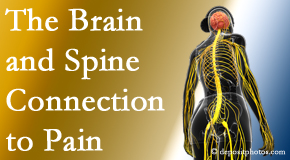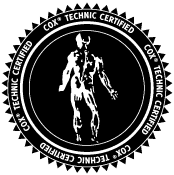Rosenberg Wellness Center Presents the Influence of the Brain/Spine Connection in Back Pain
The brain and the spine. They’re connected. They’re connected more closely than any of us appreciate as we go about our daily lives. Rosenberg Wellness Center keeps this connection in mind as we take care of our New York City back pain sufferers’ spines and listen to their stories of pain and ways of coping. New York City chiropractic care at Rosenberg Wellness Center respects the brain and spine connection and implement gentle, safe chiropractic services including spinal manipulation to reduce pain concerning both.
BRAIN CHANGES IN New York City BACK PAIN
Pain changes the brain. A person in pain feels it. Special tests today can reveal it. BOLD (blood oxygen level dependent) responses were examined after stimulating lumbar spinous processes with manipulation and demonstrated activity in the secondary somatosensory cortex, cerebellum and other brain areas. (1) Motor cortex stimulation triggers a spinal anti-inflammatory response to decrease pain. (2) Depression, anxiety, cognitive deficits often accompany chronic constriction of the sciatic nerve because of its effect on the medial prefrontal cortex. (3) Spinal manipulation may be a means to deal with the brain changes in chronic pain and its associated issues.
SHORT TERM STIMULATION’S EFFECT ON BRAIN
Stimulating the brain even for a short time may impact the pain experience. A recent study on Euclidean distance between cortical sources and temporal dynamics of plastic changes in the somatosensory cortex of the brain had even your New York City chiropractor’s head spinning a bit! What a subject! Without having to understand all these terms and measurements discussed in the study, know that the study presented that the brain, even the adult brain, is impressionable. Of course, the young developing brain is most malleable, but with the appropriate input, the older, adult brain can transform. The researchers in this study took measurements before and after stimulation and compared them on MRI. They saw a difference. More research needs to be done, but they did describe that long term experience establishes cortical organization while occasional, new and different stimulation can trigger cortical reorganization of the adult brain. Such changes have been discovered in musicians, Braille readers, and persons after spinal manipulation and stroke rehab. (4) This understanding of the brain contributes to the New York City chiropractic treatment plan!
BRAIN CHANGES WITH CHRONIC PAIN
Just how is the chiropractic treatment plan affected with such knowledge of the brain? Let us start by looking at the brain with chronic pain. The two brain regions that encode the intensity of pain and contribute to the overall experience of chronic pain are the primary somatosensory cortex and posterior insular cortex. (5) The cortex of the brain was shown to be thinner in chronic low back pain patients. Post-treatment, the dorsolateral prefrontal cortex is thicker. To the researchers, this indicated that treating chronic pain may well reestablish normal brain functions. (6) Rosenberg Wellness Center care for New York City back pain patients all day long. It’s amazing to imagine that treatment might alter more than the pain response alone!
CONTACT Rosenberg Wellness Center
Listen to this PODCAST by Dr. James Cox on The Back Doctors Podcast with Dr. Michael Johnson as he defines more plainly the brain and spine and pain connection, illustrates in more depth how the cells of the body are continually remodeling and adapting to their always-changing mechanical environment, and how chiropractic may help.
Schedule a non-surgical New York City chiropractic care appointment with Rosenberg Wellness Center for your pain, brain, and spine! The connection is there between pain and the brain. Rosenberg Wellness Center can get in the middle of those two and help you obtain some New York City pain relief.


